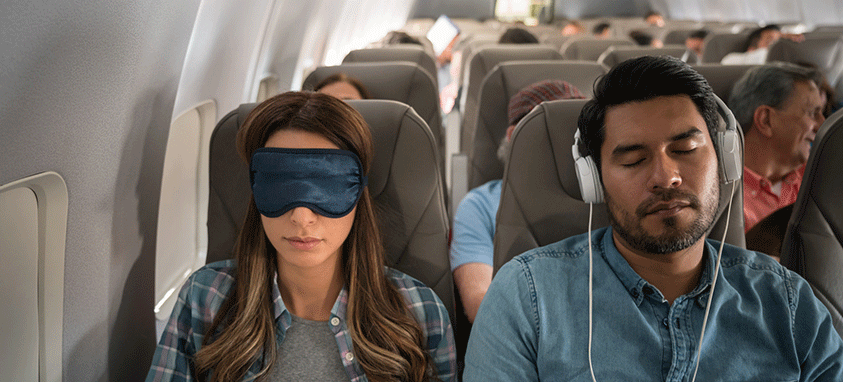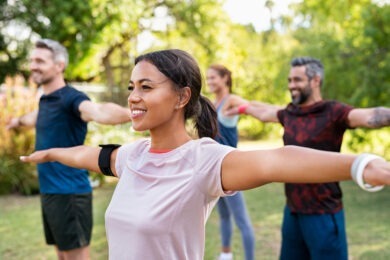Airlines are competing with in-flight wellness programs
I recently flew Turkish Airlines and was surprised to see a real doctor on the in-flight entertainment system. It was Dr. Mehmet Oz, the Turkish-American cardiothoracic surgeon known best for his daytime television program, The Dr. Oz Show.
He has produced a series of short videos and designed a selection of herbal teas for the airline’s Fly Good Feel Good program to help combat the effects of those long hours of cramped seating in a dry airplane cabin as it hurtles through time zones. I could select a host of topics to watch and read about, such as allergies, traveling with children or while pregnant, dehydration, blocked nose and ear trouble, jet lag, gas and swelling, exercise, massage, fear of flying and eating while flying.
It turns out Dr. Oz’s is not the only medical advice flying high these days. Dr. Richard Carmona, chief of health innovation for the health-spa brand Canyon Ranch, is working with Singapore Airlines. Air France uses an in-house medical aviation doctor and psychologist. Other airlines have hired their own health consultants, or have partnered with medtech companies.
Staying healthy while flying and fighting jet lag used to be entirely up to you. Especially on nonstop, long-haul flights, airlines are now rolling out in-flight wellness programs, including meditation apps, more comfy blankets and bedding, and healthier meals—and you don’t have to pay a premium to take advantage of many of them.
Strategies in Flight
Jet lag is still “the biggest elephant in the cabin,” Stephen Simpson, academic director for University of Sydney’s Charles Perkins Center, told The New York Times. He consults with Qantas Airways on its wellness offerings. “The human body is not designed to cross several time zones in such a short time, so we are basically trying to trick it into believing it’s not.” His team has worked with circadian biologists, sleep doctors, biochemical engineers, immunologists and researchers to create the Qantas program. It has also attached monitors to passengers that tracked their posture, movements and sleep.
Air France offers an in-flight course, “Taming the Plane,” which focuses on fear of flying, and its experts, including a psychologist, believe that the normal stresses of air travel—congestion in terminals, frequent delays, numbing TSA lines and sardine-like economy seating—exacerbate our bodies’ natural aversion to being transported at 30,000 feet above sea level. The airline now has a meditation app on its entertainment screens. Other airlines with meditation onboard, on longer flights at least, include United Airlines, JetBlue, British Airways and Swiss Air.
JetBlue’s content has a video that offers tips for passengers on how to sleep upright. Cathay Pacific offers “Travel Well with Yoga,” a series of videos that leads passengers through poses that can be done sitting down, such as back and hip stretches.
These wellness programs are available even to passengers in the cheapest seats.
What you eat while flying is also important to your overall well-being, and there, too, several airlines are paying attention to trends toward mindful eating. In the latest annual airline food study conducted at Hunter College NYC Food Policy Center, Delta Air Lines’ meals, snack boxes and individual snacks earned highest marks among domestic U.S. carriers. They averaged 480 calories, and are often gluten-free. JetBlue’s AmuUp box (gluten-free crackers, hummus, olives, almonds and an energy bar) was also given a shout out.
Premium Perks
As you would expect, premium seating has its special wellness perks. Chief among these, of course, is more roominess—and, in the case of long-haul flights, beds and truly reclinable seating. Amenities get upgrades, as well. After customer surveys told American Airlines that well-being—especially decent sleep—was high on its customers’ areas of concern, the airline hired bedding brand Casper to create better pillows, blankets and sleep amenities. International first-class and business-class passengers now get lumbar pillows, mattress pads, cotton blankets and pajamas.
Do all these offerings really help passengers arrive at destinations feeling more refreshed and healthy? No rigorous scientific verification is yet available, and websites that rate airlines on things such as on-time records and seating have yet to expand their oversight to wellness. I can tell you that I tried out a few of the meditation and in-flight exercises of the Fly Good Feel Good program on my Turkish flight, and they certainly seemed a calmer and more mindful way to pass the time than playing video solitaire or watching a nail-biting action film.
In the end, though, your well-being aloft is still ultimately up to you. Health experts are virtually unanimous in advising that getting up out of your seat at regular intervals and staying hydrated while in the air are the two most important ways to fly well.




